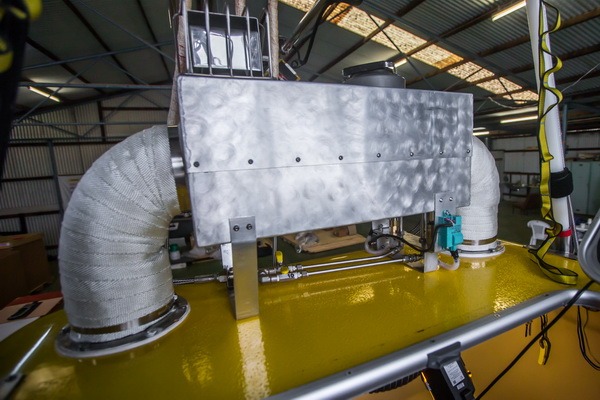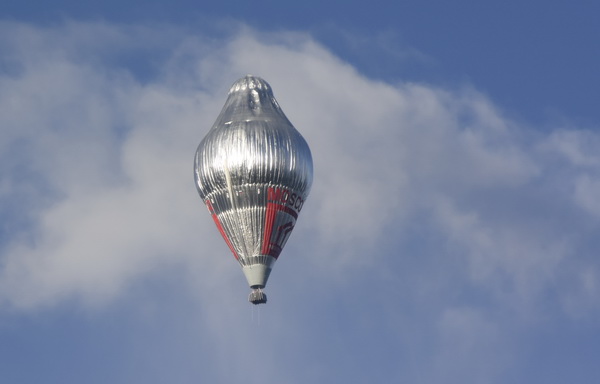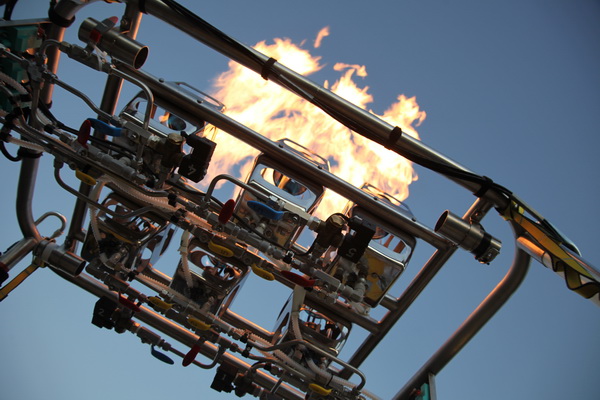Difficult night over Atlantic Ocean
Mid Atlantic and the night started with a relatively good immediate vicinity forecast. Fedor appeared to be clear of some frontal activity and the team was focusing on a strong developing low that may be encountered as the balloon moved into the Indian Ocean the following day.
The track was just south of each, speed around 200kph and altitude 8,000 metres. Air temperature a brisk minus 35 and frost continuing for form throughout the gondola except around the actual heater outlet. It was so cold that the oxygen masks had been freezing solid as breath is exhaled so Fedor had taken to swapping between warming one in his jacket and breathing through the other.

Photo: Cabin heater mounted on top of the gondola.
A message beeped on the satellite phone. Fedor was in cloud, with hail falling around him and severe turbulence blowing out the pilot lights for the burners. It was not a comfortable situation and a quick midnight phone call to the specialist weather forecaster Prof. David Dehenauw in Belgium revealed storm cloud tops well above the current height of the balloon. To fly higher would increase the cold and perhaps reduce burner performance, to go down would slow the balloon and move further into the bad weather so the recommended option, whilst still unnerving was to maintain the level and outrun the terrible conditions. It was anticipated by the forecaster that this should take perhaps two hours and sure enough in that time the balloon moved into clear air. Speed still around 200kph.

Just as everyone was settling down the call came that the onboard heater and one bank of pilot lights had failed. More early morning calls this time to the fuel system expert at Cameron Balloons. Whilst we all agreed the simultaneous failure was most unlikely to be caused by fuel exhaustion in two tanks we decided a more detailed analysis could wait and the immediate plan was a midnight tank change. For this Fedor needed to climb outside and physically move the hoses from tank to tank. Specific back up tanks with appropriate valves are located amongst the 35 tanks in total but in a logical position near the exhausted tanks. Fedor completed the tank changes and then elected to spend more time outside using the decanting hose to move liquid from primary burner tanks so backups are still available for the heater and pilot lights.

Photo:6 burners set on MORTON Roziere balloon.
04:00 local time and another call. We should ignore the severe altitude changes on the Iridium trackers we are monitoring as very severe turbulence in causing height changes of 400 metres without pilot input. 3 of the 6 burners are so covered in ice they are no longer functional and the others cannot effectively maintain altitude. Descending is not an option with 8/8 cloud and associated freezing moisture below. It is around minus 45 degrees and Fedor is just hanging on until morning.
We are hoping for no more surprises and that Fedor will make it through the night OK. Tomorrow we must focus on the Indian Ocean weather and the next met briefing.
John Wallington
Flight coordinator. Northam, Western Australia.
You can follow the balloon’s path here: https://my.yb.tl/RRTW2016
You can also view the route map at www.iridium360.ru
The official website for the project “Around the world in a Roziere balloon “Morton” can be found at a flyfedor.ru